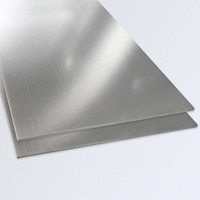| Items |

5086-H32-250-4896
Aluminum Plate - Series 5086-H32
|

5086-H32-250-48144
Aluminum Plate - Series 5086-H32
|

5086-H32-250-48240
Aluminum Plate - Series 5086-H32
|

5086-H32-250-60144
Aluminum Plate - Series 5086-H32
|

5086-H32-250-60240
Aluminum Plate - Series 5086-H32
|
|
Material
|
N/A
Aluminum
|
|
Shapeform
|
N/A
Plates
|
|
Series
|
N/A
5086-H32
|
|
Grade
|
N/A
5086
|
|
Temper
|
N/A
H32
|
|
Finish
|
N/A
Mill
|
|
Thickness
|
N/A
0.25 inches6.3500 mm
|
|
Size
|
N/A
48 x 96
|
N/A
48 x 144
|
N/A
48 x 240
|
N/A
60 x 144
|
N/A
60 x 240
|
|
Width
|
N/A
48
|
N/A
48
|
N/A
48
|
N/A
60
|
N/A
60
|
|
Length
|
N/A
96
|
N/A
144
|
N/A
240
|
N/A
144
|
N/A
240
|
|
Sheet Weight per Unit Area
|
N/A
3.456 lbs/ft²16.872192 kg/m²
|
N/A
|
N/A
|
N/A
|
N/A
|
|
Weight per Plate
|
N/A
110.59 lbs50.09727 kg
|
N/A
165.89 lbs75.14817 kg
|
N/A
276.48 lbs125.24544 kg
|
N/A
207.36 lbs93.93408 kg
|
N/A
345.60 lbs156.5568 kg
|
|
ASTM Specification
|
N/A
AMS-QQ-A-250/7 ASME SB-209 ASTM B209
|
|
Ultimate Strength
|
N/A
42 ksi
|
|
Yield Strength
|
N/A
30 ksi
|
|
Elongation percent in 2 inches
|
N/A
12
|
|
Modulus of Elasticity1
|
N/A
10.3 x 102 ksi
|
|
Resistance to Corrosion - General2
|
N/A
A
|
|
Stress Corrosion Cracking3
|
N/A
A
|
|
Workability (Cold)4
|
N/A
B
|
|
Mechinability
|
N/A
D
|
|
Brazeability5
|
N/A
D
|
|
Gas Weldability6
|
N/A
C
|
|
Arc Weldability7
|
N/A
A
|
|
Resistance Spot and Seam Weldability8
|
N/A
A
|
|
Applications
|
N/A
Unfired, welded pressure vessels, marine, auto aircraft cryogenics, TV, towers, drilling rigs, transportation, equipment, missile components
|
|
Density
|
N/A
0.096 lbs/in³
|
|
Specific Gravity
|
N/A
2.66
|


